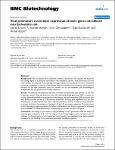Viral promoters can initiate expression of toxin genes introduced into Escherichia coli
Lewin, Astrid
Mayer, Martin
Chusainow, Janet
Jacob, Daniela
Appel, Bernd
Background: The expression of recombinant proteins in eukaryotic cells requires the fusion of the coding region to a promoter functional in the eukaryotic cell line. Viral promoters are very often used for this purpose. The preceding cloning procedures are usually performed in Escherichia coli and it is therefore of interest if the foreign promoter results in an expression of the gene in bacteria. In the case molecules toxic for humans are to be expressed, this knowledge is indispensable for the specification of safety measures. Results: We selected five frequently used viral promoters and quantified their activity in E. coli with a reporter system. Only the promoter from the thymidine kinase gene from HSV1 showed no activity, while the polyhedrin promoter from baculovirus, the early immediate CMV promoter, the early SV40 promoter and the 5' LTR promoter from HIV-1 directed gene expression in E. coli. The determination of transcription start sites in the immediate early CMV promoter and the polyhedrin promoter confirmed the existence of bacterial -10 and -35 consensus sequences. The importance of this heterologous gene expression for safety considerations was further supported by analysing fusions between the aforementioned promoters and a promoter-less cytotoxin gene. Conclusion: According to our results a high percentage of viral promoters have the ability of initiating gene expression in E. coli. The degree of such heterologous gene expression can be sufficient for the expression of toxin genes and must therefore be considered when defining safety measures for the handling of corresponding genetically modified organisms.
Dateien zu dieser Publikation
Keine Lizenzangabe
Verwandte Publikationen
Anzeige der Publikationen mit ähnlichem Titel, Autor, Urheber und Thema.
-
2013-08-08ZeitschriftenartikelCytomegalovirus Downregulates IRE1 to Repress the Unfolded Protein Response Stahl, Sebastian; Burkhart, Julia M.; Hinte, Florian; Tirosh, Boaz; Mohr, Hermine; Zahedi, René P.; Sickmann, Albert; Ruzsics, Zsolt; Budt, Matthias; Brune, WolframDuring viral infection, a massive demand for viral glycoproteins can overwhelm the capacity of the protein folding and quality control machinery, leading to an accumulation of unfolded proteins in the endoplasmic reticulum ...
-
2009-02-25ZeitschriftenartikelCross-talk between type three secretion system and metabolism in Yersinia. Schmid, Annika; Neumayer, Wibke; Trülzsch, Konrad; Israel, Lars; Imhof, Axel; Roessle, Manfred; Sauer, Guido; Richter, Susanna; Lauw, Susan; Eylert, Eva; Eisenreich, Wolfgang; Heesemann, Jürgen; Wilharm, GottfriedPathogenic yersiniae utilize a type three secretion system (T3SS) to inject Yop proteins into host cells in order to undermine their immune response. YscM1 and YscM2 proteins have been reported to be functionally equivalent ...
-
2010-05-01ZeitschriftenartikelDifferential expression of human endogenous retrovirus K transcripts in primary human melanocytes and melanoma cell lines after UV irradiation. Reiche, Janine; Pauli, Georg; Ellerbrok, HeinzHuman endogenous retroviruses (HERVs) are discussed as causative agents of various diseases including cancers. Expression of endogenous retroviral sequences can be induced by ultraviolet (UV) light, which is also considered ...

